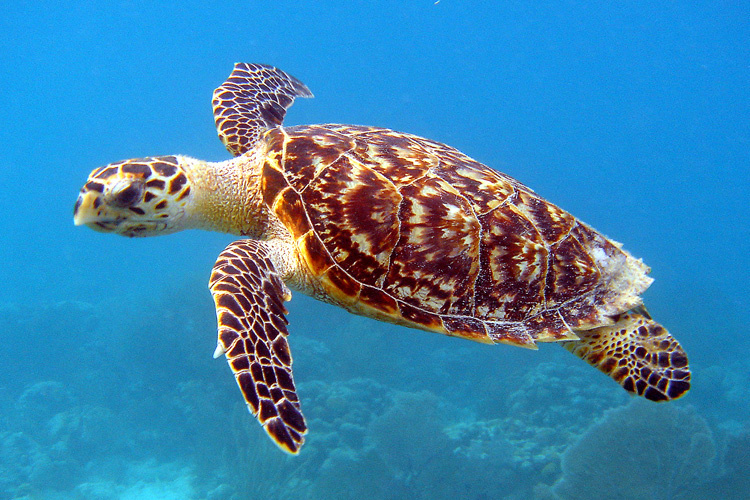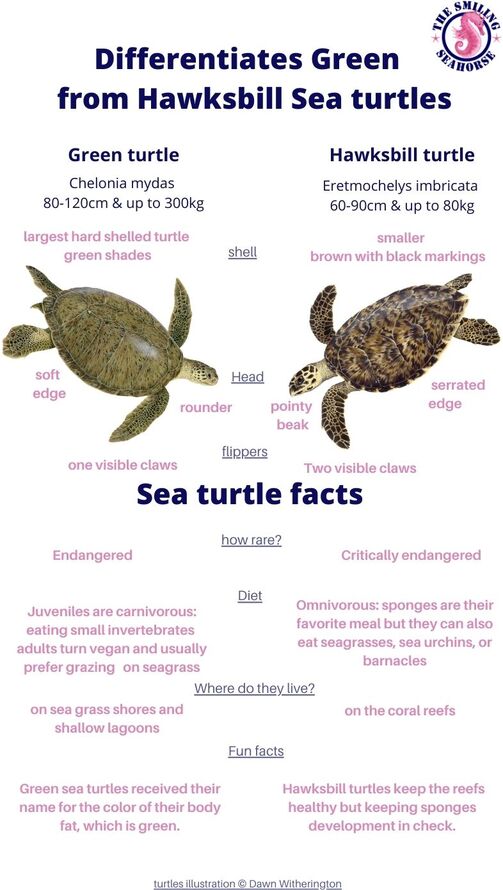Facts About The Hawksbill Sea Turtle
Ready to dive into the fascinating world of the hawksbill sea turtle? These incredible creatures are not only beautiful, but they also have some truly amazing characteristics. From their unique shell pattern to their important role in marine ecosystems, there’s so much to discover about the hawksbill sea turtle. So, grab your snorkel and let’s explore some fascinating facts about these incredible creatures!
One of the most distinctive features of the hawksbill sea turtle is its stunning shell. Unlike other sea turtles, the hawksbill’s shell is covered in a colorful pattern of overlapping scales, resembling the intricate design of a mosaic. These shells can range in colors from shades of brown, red, and orange to even black. It’s no wonder these turtles are often referred to as nature’s artists!
But the hawksbill sea turtle isn’t just a pretty face. These incredible creatures play a crucial role in maintaining the health of coral reefs. As omnivores, they have a diet that consists mainly of sponges, which are known to overgrow and suffocate coral reefs if left unchecked. By munching on sponges, hawksbill sea turtles help keep the delicate balance of the underwater ecosystem intact. So, not only are they stunning to look at, but they’re also environmental superheroes!
So, get ready to uncover even more fascinating facts about the hawksbill sea turtle. From their nesting habits to their incredible migratory journeys, these turtles have plenty of surprises in store. So, let’s dive in and explore the captivating world of the hawksbill sea turtle together!

Facts About the Hawksbill Sea Turtle
The hawksbill sea turtle (Eretmochelys imbricata) is a fascinating marine creature that inhabits tropical and subtropical waters around the world. Named for its distinctive beak-like mouth, the hawksbill turtle is known for its beautiful shell, which is highly sought after for its use in luxury goods. In this article, we will explore some interesting facts about the hawksbill sea turtle and shed light on its importance in marine ecosystems.
Physical Characteristics
The hawksbill sea turtle is a relatively small species, with adults reaching an average length of about 2 to 3 feet and weighing between 100 to 150 pounds. One of its most distinctive features is its sharp, curved beak, which allows it to reach into crevices and feed on sponges and other invertebrates. The hawksbill turtle’s shell, or carapace, is the most recognizable aspect of its appearance. It is composed of overlapping scales, or scutes, which give the shell a unique pattern of colors, ranging from shades of brown and black to yellow and orange. This striking shell is highly valued in the illegal wildlife trade, leading to the hawksbill turtle’s endangered status.
The hawksbill sea turtle has a streamlined body and flippers, which enable it to gracefully navigate through the water. Its flippers are long and narrow, with two claws on each forelimb. These flippers make the hawksbill turtle a powerful swimmer, allowing it to migrate long distances and dive to depths of up to 150 feet in search of food.
Habitat and Distribution
Hawksbill sea turtles are found in warm tropical and subtropical waters of the Atlantic, Pacific, and Indian Oceans. They inhabit coral reefs, rocky coastlines, and shallow coastal areas, where they find an abundant food supply. These turtles are known to migrate long distances between foraging and nesting grounds, often traveling hundreds or even thousands of miles.
Coral reefs are particularly important habitats for hawksbill turtles, as they provide both food and shelter. The turtles feed on the sponges that grow on the reefs, using their beak-like mouths to extract the soft tissues. In turn, the hawksbill turtle’s presence helps maintain the health of coral reefs by controlling the population of sponges, which can otherwise overgrow and smother the coral.
Life Cycle and Reproduction
Female hawksbill turtles reach sexual maturity between the ages of 20 to 30 years. They return to their natal beaches, often the same ones where they hatched, to lay their eggs. The nesting season varies depending on the region, but it generally occurs between May and November. The female digs a hole in the sand with her hind flippers and lays around 100 to 150 eggs. After covering the nest, she returns to the ocean, leaving the eggs to incubate for approximately two months.
Once the hatchlings emerge from the nest, they instinctively make their way to the water, guided by the moonlight reflecting off the ocean. This journey is fraught with dangers, as predators such as birds, crabs, and fish eagerly await the opportunity to snatch up the vulnerable hatchlings. Only a small percentage of hawksbill sea turtles survive to adulthood, making their conservation a critical priority.
Threats and Conservation
Despite their importance in marine ecosystems, hawksbill sea turtles face numerous threats that have led to their decline. The illegal trade in hawksbill turtle products, particularly their shells, has had a devastating impact on their populations. The demand for tortoiseshell products, such as jewelry and accessories, has driven the hawksbill turtle to the brink of extinction. Efforts to combat this trade include international bans on the sale and trade of hawksbill turtle products.
Hawksbill turtles are also threatened by habitat loss and degradation. The destruction of coral reefs, pollution of coastal waters, and coastal development all contribute to the decline of suitable nesting and foraging habitats. Climate change poses additional challenges, as rising sea levels and increasing ocean temperatures can impact the turtles’ reproductive success and alter their food sources.
Conservation efforts are crucial for the survival of the hawksbill sea turtle. Protected areas, such as marine reserves and national parks, provide safe havens for nesting and foraging. Education and awareness campaigns aim to reduce demand for hawksbill turtle products and promote sustainable tourism practices. Research and monitoring programs help gather important data on the turtles’ behavior and population trends, enabling targeted conservation actions.
Conclusion
The hawksbill sea turtle is a remarkable species with unique characteristics and ecological significance. Its striking appearance and important role in maintaining the health of coral reefs make it a valuable ambassador for marine conservation. By raising awareness about the challenges facing the hawksbill turtle and supporting conservation efforts, we can ensure the survival of this iconic sea creature for future generations to admire and cherish.
Key Takeaways: Facts About the Hawksbill Sea Turtle
- The hawksbill sea turtle is a species of sea turtle found in tropical waters.
- They have a unique, pointed beak that resembles a hawk’s bill, hence their name.
- Hawksbill sea turtles play an important role in maintaining the health of coral reefs by eating sponges.
- These turtles are critically endangered due to habitat loss, pollution, and illegal hunting for their beautiful shells.
- They can grow up to 3 feet long and weigh around 100-150 pounds.
Frequently Asked Questions
What is the size of a hawksbill sea turtle?
Hawksbill sea turtles are a medium-sized species, with adults typically measuring around 2 to 3 feet in length and weighing between 100 to 150 pounds. However, some individuals can grow larger, with the record for the largest hawksbill sea turtle ever measured being 3.5 feet long and weighing over 200 pounds.
It’s important to note that the size of hawksbill sea turtles can vary depending on factors such as their diet, habitat, and overall health. Additionally, males and females may have slight differences in size, with females generally being larger than males.
What do hawksbill sea turtles eat?
Hawksbill sea turtles have a specialized diet primarily consisting of sponges. Their narrow head and beak-like mouth allow them to reach into crevices and feed on sponges that other turtles cannot access. However, they are not limited to sponges alone and also consume other invertebrates such as jellyfish, sea anemones, and shrimp.
These turtles play a crucial role in maintaining the health of coral reefs as their feeding habits help control the population of sponges, preventing them from overtaking the reef and allowing other organisms to thrive.
Where can hawksbill sea turtles be found?
Hawksbill sea turtles are found in warm tropical waters around the world. They have a wide distribution, inhabiting coral reefs, rocky coastlines, and shallow coastal waters in the Atlantic, Pacific, and Indian Oceans. Some of the key regions where hawksbill sea turtles can be found include the Caribbean Sea, the Great Barrier Reef in Australia, and the Seychelles in the Indian Ocean.
These turtles are known to undertake long migrations, traveling hundreds or even thousands of miles between their nesting beaches and feeding grounds.
How long do hawksbill sea turtles live?
Hawksbill sea turtles have a relatively long lifespan, with individuals known to live for several decades. On average, they can live up to 30 to 50 years in the wild. However, there have been reports of hawksbill turtles living beyond 100 years.
It’s important to note that the exact lifespan of hawksbill sea turtles can vary depending on various factors such as predation, habitat quality, and human impacts. Conservation efforts are crucial in ensuring the long-term survival of these magnificent creatures.
Are hawksbill sea turtles endangered?
Yes, hawksbill sea turtles are listed as critically endangered by the International Union for Conservation of Nature (IUCN). Their populations have significantly declined over the years due to various threats such as habitat loss, climate change, pollution, and illegal hunting for their beautiful shell, which is highly valued in the international market.
Conservation initiatives and international agreements are in place to protect hawksbill sea turtles and their habitats. Efforts such as nesting beach protection, reducing plastic pollution, and promoting sustainable fishing practices are crucial in ensuring the survival of this species.

Final Summary: Fascinating Facts About the Hawksbill Sea Turtle
Throughout this article, we’ve delved into the captivating world of the hawksbill sea turtle and uncovered some truly remarkable facts. From its unique appearance to its crucial role in marine ecosystems, the hawksbill sea turtle has proven to be an extraordinary creature worth learning about.
One of the most intriguing aspects of the hawksbill sea turtle is its stunning shell, which is composed of a mosaic of overlapping scales known as scutes. These scutes give the turtle’s shell its distinctive appearance, resembling the beautiful patterns found on the wings of a bird. This unique feature not only provides protection but also serves as a valuable identification tool for researchers and conservationists.
Beyond its physical attributes, the hawksbill sea turtle plays a vital role in maintaining the health of coral reefs. As these turtles graze on sponges, they prevent these organisms from overgrowing and dominating the reef ecosystem. This symbiotic relationship between the hawksbill sea turtle and coral reefs highlights the interconnectedness of marine life and emphasizes the importance of conservation efforts to protect these delicate ecosystems.
In conclusion, the hawksbill sea turtle is a truly fascinating creature, both in appearance and in its ecological significance. Its distinctive shell, along with its crucial role in maintaining coral reef health, make it a remarkable species worth cherishing and protecting. By raising awareness and implementing conservation measures, we can ensure that future generations will continue to marvel at the beauty and importance of the hawksbill sea turtle for years to come.

